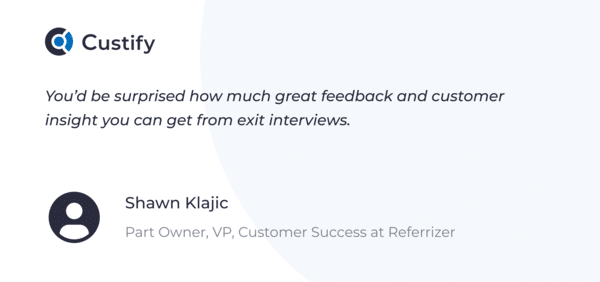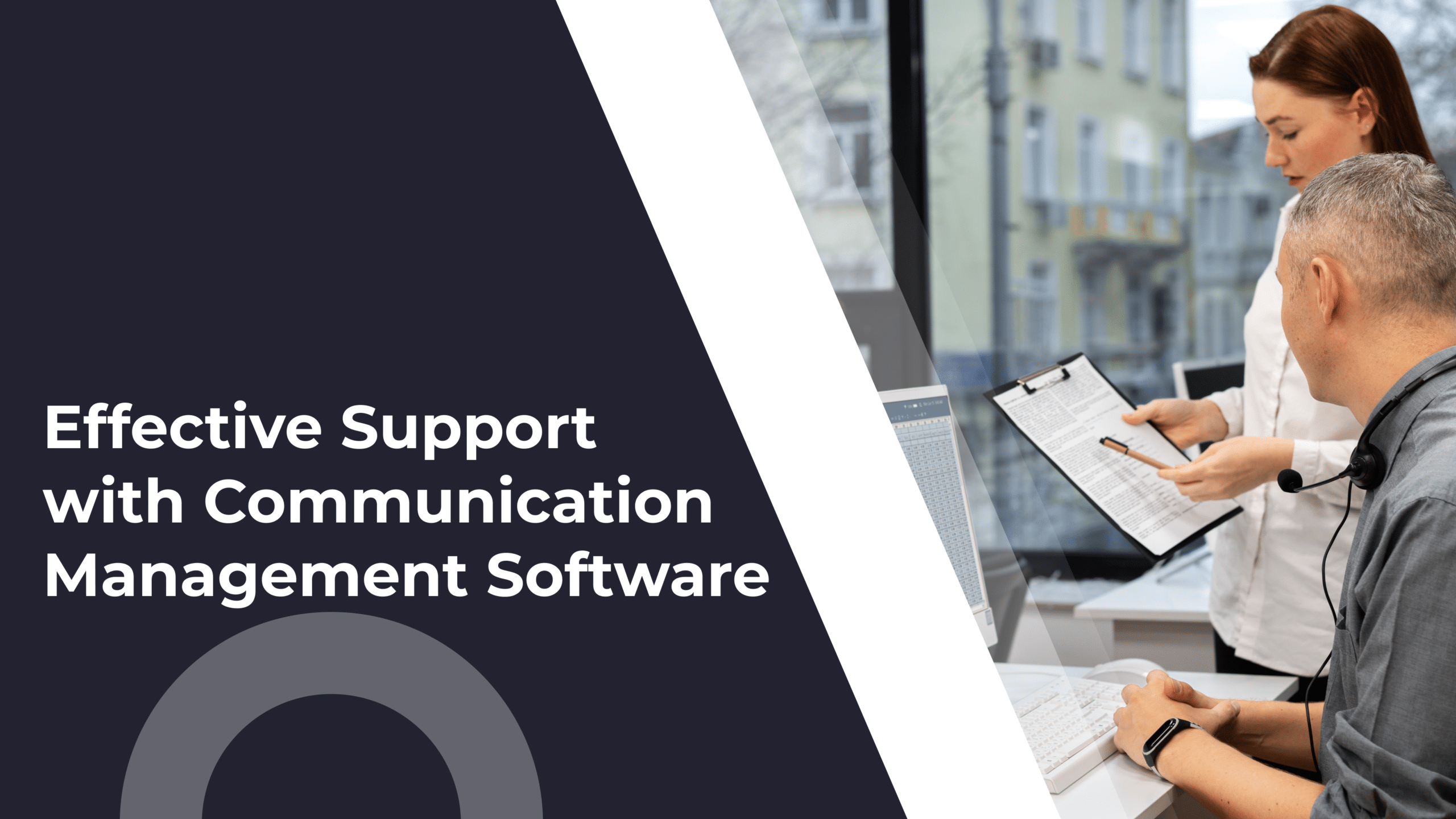The customer exit interview isn’t a desired moment. After all, who wants to see their clients leaving, right? However, this may be an opportunity to change and understand how your company can improve its products and services to increase customer retention.
You can get valuable feedback with this type of interview. It depends on how you will use the information you get. Besides, it’s necessary to define what questions to ask and what the best channel to conduct the interview is.
What Is a Customer Exit Interview?
A customer exit interview is a process conducted by businesses (usually B2B) when a client decides to end their contract or not renew it. The aim is to understand the reasons behind their departure, gather valuable feedback, and identify areas for improvement.
These interviews can be conducted through various channels such as online, email, telephone, or in-person meetings, depending on the nature of the business and the relationship with the client.
Key Questions to Ask During a Customer Exit Interview:
- What were the main factors that caused you to leave?
- How effective was our communication with you?
- What did you like and dislike about our product or service?
- How could we better serve you in the future?
The insights gained from these interviews can directly impact business strategies, helping to enhance products and services, and ultimately improve customer retention.

Customer Exit Interviews in B2C Companies
In B2C (business to customer) companies, you are dealing directly with the customers, as the name suggests. The relationship between company and client differs from B2B (business to business) companies.
For example, imagine you have an online store for cell phones. You may not even have a direct interaction with the customers. They research the product they want, find your store offers what they want at a good price, and complete the purchase.
You can engage with them by providing high-quality content via email marketing campaigns, blog posts, and social media. In a case like that, if the customer stops buying from you, it’s more suitable to make a customer exit interview via email because of how the relationship was built.
On the other hand, if you have a physical store where your team interacts personally with your customers, the type of relationship is different. This requires another approach, you can call the client or even talk to them in person to make the exit interview.
It’s also important to consider the number of clients you have, and how many are leaving at the same time. If the number is too high, it isn’t viable to conduct customer exit interviews by phone or in person, it would take too much time.
Here are some best practices and examples to consider for B2C offboarding:
- Email Surveys: Ideal for customers who prefer a less direct form of communication.
- In-Person Interviews: Suitable for businesses with physical locations and regular face-to-face interactions.
- Automated Online Forms: Efficient for gathering feedback from a large customer base with minimal effort.
- Live Chat: Allows for real-time feedback collection, especially useful for e-commerce platforms.
- Follow-Up Calls: Personalized approach for high-value customers to understand their reasons for leaving.
Examples:
- Email Survey: Send an automated survey to customers who have unsubscribed from your online service.
- In-Person Interview: Conduct a short interview with customers in a retail store when they express dissatisfaction.
- Automated Online Form: Use a pop-up form to gather feedback immediately after a subscription cancellation.
- Live Chat: Engage with customers through live chat on your website to quickly address their concerns.
Customer Exit Interviews in B2B Companies
In B2B companies, it’s common to establish a relationship with the other company that requires in-person meetings, video conferences, and calls, mainly if you are selling a service.
For example, in a marketing agency, it’s necessary to interview the customer to understand their goals, plan the marketing strategies, and present performance reports. In this case, when the client wants to end the relationship with the agency, it’s more suitable to schedule a video call or an in-person meeting to make the customer offboarding.
Here are some best practices and examples to consider:
- Video Calls: Maintain a personal touch while discussing detailed feedback remotely.
- In-Person Meetings: Best for long-term clients with significant investments in your services.
- Phone Interviews: Effective for clients who prefer a more flexible, direct conversation.
- Detailed Questionnaires: Use comprehensive forms to capture in-depth feedback from various stakeholders.
- Post-Exit Analysis Sessions: Conduct internal meetings to review feedback and plan improvements.
Examples:
- Video Call: Schedule a video conference with a client who is discontinuing a major contract to understand their reasons.
- In-Person Meeting: Meet with a key client at their office to discuss their decision to terminate the partnership.
- Phone Interview: Conduct a phone interview with a client ending a consulting agreement to gather immediate feedback.
- Detailed Questionnaire: Send a detailed questionnaire to multiple contacts within a client organization to get a holistic view of their experience.
- Post-Exit Analysis Session: Hold an internal review meeting to analyze feedback and develop action plans for improvement.
Why Are Customer Exit Interviews Important?
Understand Your Target Audience Better
Customer exit interviews can help you know your target audience pain points better, and identify what they expect from your company. For example, if the price is the reason pointed out by most of the customers for leaving, you may need to analyze if you are focusing on the right public, or if it’s necessary to change the prices.
Some practical examples of this use case:
Example 1: Price Sensitivity
- Scenario: A SaaS company discovers that many clients leave due to high costs.
- Action Taken: They introduce tiered pricing options and long-term discounts.
- Result: Enhanced retention and increased sign-ups.
Example 2: Product Fit
- Scenario: A B2B or B2C eCommerce platform finds that users struggle with a confusing interface.
- Action Taken: They redesign the UI/UX based on feedback.
- Result: Improved user experience and reduced churn.
The more you know your customers and potential customers, the better you can develop personalized strategies for them. The conversion, customer satisfaction, and retention rates will improve as a consequence.
Identify Problems
Why is the customer leaving? That’s the main question to be answered in a customer exit interview. Through that information, you can identify problems in your company and look for solutions.
You will be able to prevent major crises, create effective strategies to strengthen your brand, and avoid losing more customers too.
Through customer exit interviews you can discover problems in different areas, including:
- Customer support
- Service quality
- Product quality
- Communication
- User experience
- Sales channels

Some practical examples of this use case:
Example 1: Service Quality
- Scenario: A telecom company learns about slow customer service response times.
- Action Taken: Implemented a new CRM system and expanded support staff.
- Result: Reduced complaints and increased satisfaction.
Example 2: Product Quality
- Scenario: A clothing retailer gets feedback on product durability issues.
- Action Taken: Switched suppliers and enhanced quality control.
- Result: Lower return rates and higher repeat purchases.
Learn How to Enhance Your Products and Services
Negative feedback isn’t pleasant to hear, but it’s useful if you know how to turn it into actions for improvement. Customer exit interviews provide precious information, and one of the main benefits is the opportunity to improve.
54% of B2B buyers use review sites in their decision-making stage. If customers are leaving your company unsatisfied, they may leave bad reviews on those same sites. However, if you already identified the problems and solved them, you can change this situation by having good reviews from customers you were able to retain.
Turning negative reviews into actionable improvements is the main challenge here. The first step, after making the exit interviews, is organizing the data collected and identifying the most important points, which includes the main reasons for stopping buying from your company.
After that, you need to identify what can be done to change the situation. For instance, if the main complaints were delivery time and shipping costs. What can be done to reduce the time and the costs? You can negotiate with partner companies or seek new ones. If what is increasing the delivery time is the product manufacturing, are there ways to accelerate it? Work with your team to find the best solutions.
Some practical examples of this use case:
Example 1: Feature Development
- Scenario: A software company identifies a missing feature customers want.
- Action Taken: They prioritize developing and launching the feature.
- Result: Increased user engagement and higher renewals.
Example 2: Customer Support Improvements
- Scenario: A subscription service finds its support is not accessible enough.
- Action Taken: They expand support hours and add a live chat feature.
- Result: Improved feedback and a higher net promoter score (NPS).
Prevent Negative Reviews and Improve Brand Reputation
Customer exit interviews can also play a key role in protecting and enhancing your company’s reputation. By understanding the reasons why customers are leaving, you can proactively address any issues before they lead to negative reviews online or through other channels.
As mentioned before, 54% of B2B buyers use review sites in their decision-making process. By using the insights from exit interviews to improve your products, services, and overall customer experience, you can minimize the risk of damaging reviews.
Furthermore, a thoughtful offboarding process demonstrated through the exit interview can leave a positive final impression, even with departing customers. This can help maintain goodwill and potentially lead to future business or referrals down the line.
By proactively addressing pain points and showing customers you value their feedback, customer exit interviews enable you to protect and even enhance your company’s brand reputation over time.
Some practical examples of this use case:
Example 1: Shipping Delays
- Scenario: An e-commerce business identifies that delays in shipping are a major issue for customers.
- Action Taken: They partner with a more reliable logistics provider and improve order tracking.
- Result: Customer satisfaction improves, leading to better reviews and fewer returns
Example 2: Misaligned Expectations
- Scenario: A subscription box service finds that customers are disappointed with the contents of their boxes.
- Action Taken: They offer personalized customization options and clearly communicate what each box will include.
- Result: Higher customer satisfaction and positive word-of-mouth referrals.
Improve Customer Retention
The cost of conquering new customers can be five times more expensive than customer retention. Learning about the mistakes that caused a customer to end the relationship with your company will help you avoid repeating them with others.
Good customer service is one of the factors that contributes to retaining customers. If you identify, through exit interviews, that your clients aren’t satisfied with the way they are treated, you can change the situation in time to avoid losing more customers.
Some practical examples of this use case:
Example 1: Competitor Analysis
- Scenario: A fitness app learns users prefer a competitor’s functionality.
- Action Taken: They enhance their app’s features to match the competitor.
- Result: Reduced churn and increased downloads.
Example 2: Communication Strategy
- Scenario: A marketing agency finds clients feel uninformed about campaign progress.
- Action Taken: They introduce monthly reports and regular check-ins.
- Result: Strengthened client relationships and higher retention.
How to Do a Customer Exit Interview
Choose the Best Channel to Do the Customer Exit Interview
It’s fundamental to set what communication channels are more suitable for the interview based on your client profile and the main channels you use to communicate with each other.
The main channels where exit interviews are conducted are in-person meetings, video call, live chat, email, and call. You need to analyze your context to choose the best one.
For example, Imagine a brand is ending a contract with a marketing agency, and the manager responsible for the account has periodic in-person meetings with the client. Then, it may be more suitable to conduct the interview in the meeting to finalize the contract.
If your customer is always busy, an in-person meeting or a call may be difficult for them, and it’s better to send the interview questions via email. You can do it via live chat on your website too. It’s important to analyze the context.
Video and telephone calls are good because you can develop the conversation better, and clarify right away any doubt you or the customer may have. However, it takes more time, which may cause more clients to turn down your invitation for the interview.
Email exit interview is more practical, though, you can make a questionnaire and send it to the customer, and even use only multiple questions to save time. The problem is you won’t be able to interact in real-time and solve your doubts as the person answers the questions.
The live chat may be a solution to that problem. You type the questions, and the customer answers in a real-time conversation, but it may take more time than an email interview.
Ask for the Interview at the Time of the Cancellation
Timing is important for customer exit interviews. You should conduct them right after the client’s cancellation. They can answer more accurately why they are leaving because the event is recent.
It may seem odd for the customer to answer an exit interview months after leaving your company. Besides, they are less likely to be compelled to participate in the interview.
When the customer asks to cancel the contract, you may ask them about the exit interview when you deliver the cancellation documents. Explain the interview won’t take long, and emphasize how important their participation is.
Define the Customer Exit Interview Questions
You and your team must create a script for the interview, and define what you will ask, whether the interview will happen through email, call, or a meeting. To select the questions, first ask what you want to know from the customers, and what information will help you avoid losing more customers.
Define the questions based on the factors that are relevant in your industry sector and who your target audience is. For example, one of the main reasons B2B companies lose clients is the lack of alignment with the customer goals. Therefore, you need to understand if their objectives were met.
In B2C companies, the price can be a deciding factor in whether the customer will continue buying from your company. In the exit interview, include questions about the relation between the product cost and the benefits offered.
State the Time Required to Take the Interview
For the customer to be able to tell if they can participate in the interview, it’s important to let them know how much it will take from their time. Therefore, when you ask them to participate, anticipate the time required.
Keep in mind that a customer exit interview shouldn’t take long. This is a way to show you understand how your client’s time is valuable, and that you respect it.
Show Your Appreciation
Before the interview, thank the customer for accepting your request and emphasize how their participation is important. You can also send a thank you note after the interview to reinforce your appreciation.
Show your appreciation by saying thank you, arriving on time if the interview is in person, and not taking too much time from the customers.
Pre-Exit Interview Example
“Thank you for taking the time to meet with us today. Before we dive into the conversation, we don’t mind any critical feedback. We value your honest opinion and want to have an open conversation “
Post-Exit Interview Example
“Thank you for taking the time to provide this valuable feedback. I’m looking forward to sharing your answers with the rest of the team.”
Listen Actively
If the customer exit interview happens in person or via a call, ensure to show the customer you are actively listening to their answers. Try not to interrupt them or engage in multitasking, this gives a bad impression and can make them feel like you don’t care about their opinions.
Offer your undivided attention, and make follow-up questions to certify you understood what they mean with each answer.
For example:
- Do you mean the main reason you decided to end the contract is the price?
- You mentioned you had problems with customer support, can you explain what were these problems?
- As you said, you didn’t enjoy all the product features. Did that happen because you didn’t know the product’s benefits or they weren’t pertinent to you?
Don’t Try To Win Them Back
The customer exit interview isn’t the moment to try to persuade them not to disengage from your company. Show you respect their decision and that you genuinely want to understand their reasons to learn from them, always emphasizing the importance of their feedback.
Analyze the Information Gathered
Doing the interview doesn’t mean the work is complete, on the contrary, it’s time to analyze the information you received. Put it together with other data such as market and competitor analysis, sales key performance indicators, and other feedback you have received.
You can organize the data gathered by integrating it to the customer profiles in the CRM (customer relationship management) software of your choice. If you already use a CRM, you are probably acquainted with its features, which include the history of each customer interaction. Adding the interview data will help you get more insights. Some CRM software even count on AI to analyze data.
Another option to organize all the information is creating sheets with Excel and Google Sheets, for example. Group the answer by categories, and create charts to add to your reports. It’s important to have a critical perspective to understand what the interview answers are revealing.
Then, along with your team, you can understand how to take this information and turn it into actions to improve your company’s results. With the information collected from the interviews try to answer the questions:
- Are you targeting the right audience?
- Does your product provide the tools people want and need?
- Is there anything preventing your customers from enjoying all the benefits your products and services offer?
- Do your customers have the level of support they need?
- What are your competitors doing differently?
14 Question Examples for a Customer Exit Interview
- What were the main factors that caused you to leave?
- When did you make the decision to leave?
- What are the trigger(s) that led you to cancel?
- Why did you initially sign up for [product name]?
- On a scale of 1-10, would you recommend our services to a friend or colleague?
- How effective was our communication with you, on a scale of 1-10?
- How would you rate [product name] on a scale of 1-10?
- What did you like about our product or service?
- What didn’t you like about our product or service?
- What problems were you able to solve with the [product name]?
- Did our company provide you with good value for your investment?
- How would you rate your interactions with our team?
- Was our onboarding process easy to understand?
- How could we better serve you in the future?
Those are general examples, remember to adapt the questions to your company’s reality, considering the products and services you offer, and your industry sector.
Potential Risks During Customer Offboarding
While conducting customer exit interviews and offboarding customers, there might be a few running risks that could be negatively affecting the business. It is necessary to identify these risks and come up with an approach to mitigate them effectively.
Data Security Breach
When a customer leaves, there may be mishandling of sensitive data. Be sure that strong data protection protocols and continuous threat exposure management are established to keep customer information secure during and after the process of offboarding.
Example: Securely store all customer data and keep strict access controls. Conduct regular security policy audits and use advanced cybersecurity software to prevent unauthorized access
Negative Word-of-Mouth
Unhappy customers are likely to spread this unhappiness to others, who in turn, will damage the company’s reputation. Managing their unhappiness by addressing their issues during termination of the relationship will help minimize this.
Example: If the customer is leaving because of poor service, try to correct their problems or give them some goodwill gesture. This can make all the difference between a good and a bad review of the experience that has otherwise been dreadful.
Violation of Compliance
The offboarding process should not overlook adherence to the data security framework; non-compliance brings along legal implications. Ensure all the processes conform to relevant laws and standards.
Example: Regularly reviewing and updating your offboarding procedures in line with regulations such as GDPR or CCPA. Training your team on best practices for compliance.
Case Study: How Referrizer Recovered 25% of Cancelled Clients Through an Offboarding Process Made with Custify
You need the right tool for your offboarding process, especially if you want to automate and scale some of it. Here’s how Custify helped Referrizer recover 25% of churned clients:
Referrizer’s Challenge: During a challenging period, Referrizer faced 110 client cancellation requests, signaling a critical issue. They needed to understand why customers were leaving and develop an effective offboarding process.
Custify’s Solution: By integrating Custify, Referrizer leveraged detailed customer insights and automated workflows to identify churn causes and address them. Here’s how Custify played a crucial role:
- Comprehensive Customer Insights: Provided a 360-degree view of customer activity, usage patterns, and health scores, enabling Referrizer to analyze each account thoroughly.
- Proactive Engagement: Utilized automation to ensure each cancellation request went through a detailed offboarding interview, enhancing client relationships and understanding their needs.
- Tailored Counteroffers: Based on the insights gathered, Referrizer created personalized counteroffers to address specific client concerns, such as offering free extensions during the COVID-19 pandemic.

Results Achieved: Through this data-driven offboarding process, Referrizer managed to recover 25% of the clients who initially wanted to cancel. This equated to significant cost savings and improved customer satisfaction. Here are some key results:
- 25% Client Recovery: Successfully re-engaged 28 out of 110 clients who wanted to cancel.
- $56,000 Annual Savings: Achieved within just two months, with potential annual savings of approximately $336,000 if the process continues.
- Enhanced Customer Relationships: Built stronger, empathetic relationships with clients by addressing their specific needs and concerns.

Referrizer’s success with Custify demonstrates the power of a structured offboarding process supported by robust customer success tools. By leveraging Custify’s features, Referrizer not only reduced churn but also strengthened their customer relationships and achieved substantial cost savings. This case highlights the importance of having the right tools to manage customer offboarding effectively.
Enjoy the Insights You Can Take From Customer Exit Interviews
Now that you know what a customer exit interview is, and how to conduct one, take the opportunity to put this into practice. Include these interviews as part of your strategy to increase customer retention and sales.
As unpleasant as losing a customer can be, it’s possible to look at it from another perspective. Customer exit interviews are a chance to learn, ensure to explain that to your team so get on board with you on implementing them.




